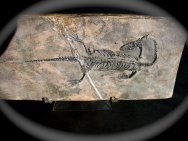 Description:
This is a good quality ventral (underside) specimen of this intriguing
genus. Its death pose is somewhat awkward, head and neck bent,
facing left. Note the excellent bone detail of the back legs,
tail and ribs. Description:
This is a good quality ventral (underside) specimen of this intriguing
genus. Its death pose is somewhat awkward, head and neck bent,
facing left. Note the excellent bone detail of the back legs,
tail and ribs.
Imagine being able to afford a swimming reptile from the Triassic.
Until about four years ago these were available in large numbers
on the world market. The Chinese authorities since then have prohibited
the export of almost all fossils. Accordingly, this is a good time
to acquire one of these specimens before they become scarce and
much more expensive.
Keichousaurus is a genus of marine reptile in the pachypleurosaur
family which went extinct at the close of the Triassic in the Triassic-Jurassic
extinction event. The name derives from Kweichow (now Guizhou Province)
in China where the first fossil specimen was discovered in 1957.
They are among the most common sauropterygian fossils recovered
and are often found as nearly complete, articulated skeletons,
making them popular among collectors. Keichousaurus, and the pachypleurosaur
family broadly, are sometimes classified within Nothosauroidea,
but are otherwise listed as a separate, more primitive lineage
within Sauropterygia.
Keichousaurus,
like all sauropterygians, was highly adapted to the aquatic  environment.
Individuals of this genus ranged from 15 - 30 cm in length, and
had both long necks and long tails, with
elongated, five-toed feet. The pointed head and sharp teeth in
this genus also indicate that they were fish-eaters. Some recovered
specimens feature an especially developed ulna suggesting they
may have spent some time on land or in marshes. In addition fossil
evidence suggest also a pair of fossilized pregnant marine reptiles
called Keichousaurus hui, show they had a mobile
pelvis to give birth to live young rather than laying eggs. environment.
Individuals of this genus ranged from 15 - 30 cm in length, and
had both long necks and long tails, with
elongated, five-toed feet. The pointed head and sharp teeth in
this genus also indicate that they were fish-eaters. Some recovered
specimens feature an especially developed ulna suggesting they
may have spent some time on land or in marshes. In addition fossil
evidence suggest also a pair of fossilized pregnant marine reptiles
called Keichousaurus hui, show they had a mobile
pelvis to give birth to live young rather than laying eggs.
|

